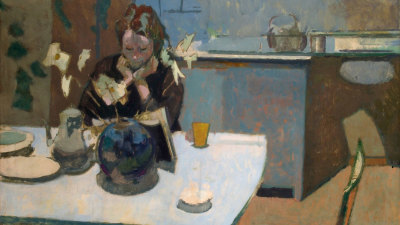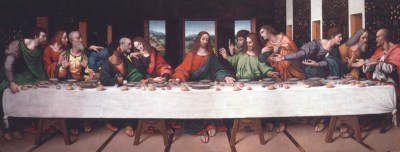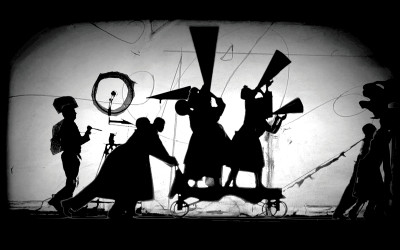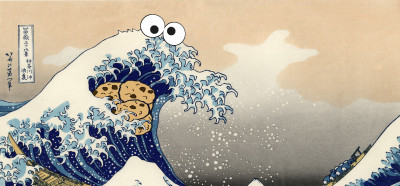10 art exhibitions to see in July
10 art exhibitions to see in July
By Robert Heath
Published 1 July 2017
From the colourful abstract paintings of the late Howard Hodgkin to a group show exploring Surrealism’s influence on female artists, here are some of the exhibitions not to miss this July.
-
Dreamers Awake
White Cube Bermondsey until 17 September
Bringing together more than 100 works across a variety of media, including painting, photography, film and installation, this group show delves into the subconscious and traces the influence of Surrealism on a diverse group of 20th- and 21st-century women artists. Artists include original Surrealist Claude Cahun, who explored gender and identity in her groundbreaking self portraits; Alina Szapocznikow, who sculpted disembodied and fragmented body parts using casts of her own body; and contemporary painter Julie Curtiss, who works with vivid colours and faceless figures to create ambiguous female forms.
-

Hayv Kahraman , T25 and T26 , 2017 .
© Hayv Kahraman. Courtesy of the arist and Jack Shainman Gallery, New York.
-
Howard Hodgkin: Painting India
The Hepworth Wakefield Wakefield, 1 July – 8 October
Following a major retrospective of the late painter’s career earlier this year at the National Portrait Gallery, this exhibition focuses on Hodgkin’s deep engagement and fascination with India, which he visited almost annually from the 1960s onwards. The British artist described his paintings as being “impressions” – of people and places – rather than pure representations, and in the show’s colourful, expressive paintings it is easy to see the mark this bustling and vibrant country left upon him. Some works are more literal, such as Mrs Acton in Delhi (1967-71), in which a reclining female figure is clearly visible, whereas others like Bombay Sun (1972-73) are more abstract, with the sun’s rays represented by a strips of amber and red paint.
-

Howard Hodgkin , In the Garden of the Bombay Museum , 1978-82 .
© Howard Hodgkin. Courtesy the artist and Gagosian.
-
John Minton: A Centenary
Pallant House Gallery, Chichester, 1 July – 8 October
John Minton was one of the major figures in the Neo-Romantic school in Britain in the 1940s, painting landscapes that charted a changing world but which also drew influence from 19th-century precursors such as the pastoral painter Samuel Palmer. Minton painted varied scenes from wartime and post-war Britain, as well as from more exotic locations in Europe and the Caribbean, creating dense canvases, often with flattened perspective. This major exhibition marks the centenary of his birth and focuses on his varied contributions to British art, including his later turn towards portraiture. Minton took his own life aged just 40, struggling to cope in a society in which his homosexuality was both illegal and stigmatised, and in an art world from which he felt increasingly alienated. He resisted the trend towards abstract art, and the intimate portraits on display here of friends, students and lovers from his later years present their sitters with directness and emotional intensity.
-

John Minton , Landscape Near Kingston, Jamaica , 1950 .
Pallant House Gallery (Hussey Bequest, Chichester District Council, 1985) © Royal College of Art.
-
Jac Leirner: Add It Up
Fruitmarket, Edinburgh, 1 July – 22 October
In her first solo show in Scotland, Brazilian artist Jac Leirner continues her fascination with seemingly mundane and functional everyday objects, creating sculptural works that place her in the traditional of Marcel Duchamp and his readymades. This exhibition collates both new and old work by Leirner, showcasing works made from objects such as rulers, ropes, ashtrays and aeroplane boarding passes. By obsessively ordering, rearranging and reassembling these apparently low-value, purely utilitarian materials, Leirner creates artworks that are both aesthetically pleasing and which tell stories about the overlooked objects that surround us.
-

Jac Leirner , Linkiamo , 1982 .
Courtesy of the artist, Fortes D'Aloia & Gabriel, and White Cube.
-
Andrea Zittel: The Flat Field Works
New Art Centre, Salisbury, 8 July – 17 September
This exhibition of recent work by American artist Andrea Zittel continues her preoccupation with fusing art, architecture and design to create objects that straddle the boundary between form and function, artwork and tool. Rather than see functionality and art as different or even oppositional concerns, responding to the basic necessities of human life is a primary element of Zittel’s art, which in the past has included sculptures and installations to be used and lived in. The Flat Field Works includes multifaceted works of sculpture, painting and textile that are simultaneously beautiful, functional and referential to art history. Bench (After Judd) #1 (2014), a wide, flat bench overlaid with a fabric mat featuring simple geometric shapes and a restrained palette of greys, yellows and browns, echoes both the designs of the Bauhaus and the minimalist furniture of American artist Donald Judd.
-

Andrea Zittel , Planar Pavilion , 2014 .
© Andrea Zittel. Courtesy of Sadie Coles HQ and New Art Centre.
-
Soul of a Nation: Art in the Age of Black Power
Tate Modern, London, 12 July – 22 October
African American art and identity are the subjects of this major exhibition (also previewed by Bonnie Greer in the Summer issue of RA Magazine). Focusing on the years from 1963 to 1984, Soul of a Nation explores how artists responded to the fundamental changes in race relations and American cultural identity during the period. Over 60 artists feature, including key collectives such as the Spiral Group and AfriCOBRA; painters Barkley L. Hendricks and Wadsworth Jarrell; Royal Academician, Frank Bowling, who moved to New York in the mid-1960s; and non-Black artists such as Andy Warhol. The works on display feature a diversity of approaches, from the abstract geometrical paintings of Jack Whitten and William T. Williams, to the photographic depictions by Roy DeCarava and Herbert Randall of both ordinary Black Americans and iconic figures such as Malcolm X and John Coltrane. At a time when it is necessary to proclaim that “Black Lives Matter”, this exhibition is more than just a historical overview and resonates powerfully today too.
-

Romare Bearden , Pittsburgh Memory , 1964 .
© Romare Bearden Foundation. Collection of Halley K Harrisburg and Michael Rosenfeld, New York, NY / DACS, London.
-
The Encounter: Drawings from Leonardo to Rembrandt
National Portrait Gallery, London, 13 July – 22 October
This collection of Old Master portraiture brings together drawings from some of the major figures of the European Renaissance, including eight Holbein portraits borrowed from the Royal Collection. The portraits, which range from hastily drawn sketches to more polished works, showcase the extraordinary ability of the artists to capture something of the sitters’ essences using only the most rudimentary materials. The sitters range from noblemen, such as in Albrecht Dürer’s sketch of the Baron Morley, to labourers, as in Carlo Dolci’s drawing of his shoemaker.
-

Annibale Carracci , The Lutenist Mascheroni , 1593-94 .
Royal Collection Trust © Her Majesty Queen Elizabeth II.
-
Jiro Takamatsu: The Temperature of Sculpture
Henry Moore Institute Leeds, 13 July – 22 October
Jiro Takamatsu was a post-war Japanese artist whose practice began with painting and later included performance art and public interventions as part of the Hi-Red Center collective. This show, the first institutional solo exhibition of his work to take place outside his home country, focuses on his sculpture, for which he was best known. Takamatsu, who died in 1998, worked with traditional materials such as marble and wood, but also utilised everyday ephemera like bottles, string and cloth. Examples of both approaches are on display here, as are a collection of his drawings and other documents. In one work on show, No.162 (1966), a classical marble bust of a male figure is given a startling makeover, with yellow paint applied to the hair and face. A major figure in post-war Japanese art, this exhibition demonstrates his importance to experimental sculpture internationally in the 20th century and beyond.
-

Jiro Takamatsu , No. 162 , 1966 .
© The Estate of Jiro Takamatsu. Courtesy of Yumiko Chiba Associates / Stephen Friedman Gallery / Fergus McCaffrey.
-
Zanele Muholi: Somnyama Ngonyama, ‘Hail, the Dark Lioness’
Autograph ABP, London, 14 July – 28 October
A series of 60 self portraits comprise this exhibition, in which South African artist Zanele Muholi uses her body to explore her identity and the politics of race. In each photograph Muholi takes on a different appearance, using different forms of dress and props including scouring pads, banknotes, clothes pegs and a mirror to emphasise the different facets of herself as a black, African, queer woman. The images have been altered with the contrast increased, allowing Muholi to amplify her blackness. Muholi’s photography functions as both art and activism. She had previously taken photographs of marginalised LGBT communities in her home country before turning the camera on herself.
-

Zanele Muholi , Sebenzile, Parktown , 2016 .
© Zanele Muholi. Courtesy of Stevenson, Cape Town & Johannesburg / Yancey Richardson, New York.
-
Rose Finn-Kelcey: Life, Belief and Beyond
Modern Art Oxford Oxford, 15 July – 15 October
This first posthumous exhibition of the late British artist Rose Finn-Kelcey, who died in 2014, covers her practice from the 1970s to the end of her life. Kelcey moved freely between media and materials, covering collage, photography and conceptual art. The themes in her work varied widely too. She tackled power and politics in works such as Power for the People (1972), in which flags bearing those words were hung from Battersea Power Station in London, and Bureau de Change (1987), a reproduction of Vincent Van Gogh’s Still life: Vase with Fifteen Sunflowers (1888), created in response to the sale of Van Gogh’s painting for a multi-million figure fee. Kelcey was also highly influenced by feminism and spirituality, and these currents can be seen in works here that explore individual empowerment and identity.
-

Rose Finn-Kelcey , The Restless Image , 1975 .
Tate Collection, courtesy of the Estate of Rose Finn-Kelcey.













